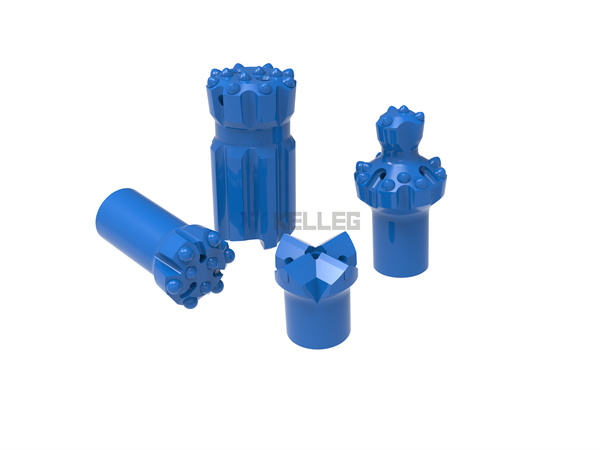2020 官网升级中!现在您访问官网的浏览器设备分辨率宽度低于1280px请使用高分辨率宽度访问。
The rock drill bit is an indispensable tool in engineering operations. It can effectively break rocks, speeding up project progress and improving work efficiency. However, numerous varieties of rock drill bits are available in the market, each designed to cater to distinct operating conditions and varying rock hardness levels. Therefore, selecting the appropriate rock drill bit for your specific requirements becomes a pivotal decision.
Types of rock drill bits

Rock drill bits include chisel bits, cross bits, tapered bits, threaded bits, down-the-hole bits, etc.
Chisel bit: It has a relatively simple manufacturing process, convenient regrinding, reliable work, and strong adaptability to rock mass performance. It is often used with light internal combustion, electric, pneumatic, and hydraulic rock drills to drill rock holes with a diameter of less than 50mm in various types of rock.
Cross bit: The diameter of the drill bit is in the range of 29-48mm, and it has strong adaptability to rock drilling conditions and is almost not limited by the rock drilling type and rock mass.
Tapered button bit: It is a kind of drill bit used in combination with the pneumatic rock drill and the tapered rod. After connecting with the drill rod, the drilling operation is carried out.
Threaded bit: Because of its reliable connection, It can transmit large torque, and it is convenient to extend the drill rod, so it is mostly used on drill stands or drilling rigs to drill large and deep rock holes. The specifications commonly used in various countries are R22, R25, R28, R32, R38, T38, T45, and T51.
DTH bit: The commonly used diameter of the DTH drill bit is 65~130mm, DTH rock drilling rig is used in medium and large aperture open-pit rock drilling projects. The down-the-hole drill bit has stable rock drilling performance and is easy to use and grind.
How to choose a rock drill bit that’s right for you?
Power and type of rock drill
Different power and types of rock drills require different sizes and properties of rock drill bits to ensure optimum performance and protection of the rock drill.
Physical properties of rock
Physical properties such as rock density, hardness, and abrasiveness also affect the selection of rock drill bits. When dealing with rocks characterized by high density, hardness, or abrasiveness, it is imperative to opt for a rock drill bit that exhibits superior durability and wear resistance.
Operating environment and conditions
Operating environment conditions such as temperature, humidity, air pressure, and ventilation will also affect the selection of rock drill bits. Choosing a rock drill bit with specialized performance becomes essential in such unique environments as high temperature, low temperature, high pressure, or high altitude.
Operation efficiency
Different types and specifications of rock drill bits have varying working efficiencies. When selecting a rock drill bit, you need to consider the requirements for operating efficiency and select a suitable rock drill bit type and specification. At the same time, to obtain the best drilling speed, we must choose a rock drill bit whose total contact area is between the carbide and the rock formation to get the best single-impact drilling amount. From the perspective of drilling speed, the conical button bit has the highest drilling speed index, followed by the spherical button bit and then the cross bit.
Economical and cost-effective
When selecting a drill bit, it’s crucial to consider not only the performance but also the cost and maintenance considerations of rock drill bits. In the process of evaluating performance and applicability, it is equally important to factor in economy and cost-effectiveness, ensuring sustainable benefits over the long term.
Various rock drill bits exhibit unique adaptability to diverse excavation and production conditions. Consequently, when selecting a rock drill bit, it’s crucial to consider multiple factors and base the decision on the specific circumstances. Opting for the right rock drill bits not only enhances efficiency but also contributes to reducing the overall cost of engineering work.